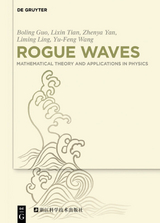Rogue Waves
De Gruyter (Verlag)
978-3-11-046942-4 (ISBN)
B. Guo, IAPCM, China; L. Tian, Nanjing Normal U., China;, Z. Yan, ISS, CAS, China; L. Li, South China U. of Tech., China.
Table of content:
Chapter 1 Introduction and updates on rogue wave research
1.1 Research history and progress on rogue wave phenomenal
1.2 Key experiments on rogue wave
1.3 Research methods and physical mechanism of rogue wave
1.4 Linear and non-linear mechanism of rogue wave
1.5 Rogue wave formation; mechanism and characteristic
1.6 Rogue wave simulation; experiments, statistical and numerical methods
1.7 Rogue wave solution to nonlinear partial differential equation
1.8 Rogue wave in optics
1.9 Rogue wave in finance
1.10 Rogue wave in non-autonomous system
Chapter 2 Solution to rogue wave formation; generalized Darboux transformation
2.1 classical Darboux transformation
2.2 Darboux transformation for KdV equation
2.3 Darboux transformation for NLS equation with N component
2.4 Rogue wave solution to NLS equation with two component;breathers, solitons
2.5 Darboux transformation for NLS equation
2.6 Darboux transformation for DNLS equation; high-order solitons
Chapter 3 Solutions to rogue wave formation; Bilinear transformation, algebro-geometric reduction
3.1 Hirota bilinear method; solitons for NLS equation and DS-I equation
3.2 Reduction for KP equation
3.3 Algebro- geometric reduction; Fredholm determinant, solution to rogue wave formation
Chapter 4 rogue wave solution to nonlinear physical model and parameter control
4.1 Introduction of rogue wave in physical studies
4.2 Time-modulated NLS equation; one dimensional nonlinear physical model, symmetry analysis, solutions
4.3 (3+1)-dimensional time-modulated GP/NLS equation; three dimensional nonlinear physical model, symmetry analysis
4.4 Generalized time-modulated high-order NLS equation
4.5 Two dimensional BEC equation
4.6 (2+1)-dimensional non-local NLS equation
4.7 Discrete Ablowitz-Ladik-Hirota lattices
"The book is a research monograph that provides the reader with the observation that rogue waves can be modeled by PDEs describing fluid motion. It is a comprehensive resource for researchers in the applied mathematics, optical physics, geophysics, and ocean engineering fields." MAA Reviews
"After reviewing the physical mechanisms behind rouge waves the present monograph discusses the construction of explicit solutions corresponding to such waves for a large number of important models using Darboux-type transformations, the Hirota bilinear method, the algebro-geometric approach and the inverse scattering transform. In addition it contains an overview of the current literature (both theoretical and experimental) on this topic. The presentation is aimed at researchers working in applied mathematics and engineering."
G. Teschl in: Monatshefte für Mathematik 190 (2019), 210
| Erscheinungsdatum | 30.06.2017 |
|---|---|
| Co-Autor | Zhejiang Science and Technology Press |
| Zusatzinfo | 63 b/w ill., 1 b/w tbl. |
| Verlagsort | Berlin/Boston |
| Sprache | englisch |
| Maße | 170 x 240 mm |
| Gewicht | 543 g |
| Themenwelt | Mathematik / Informatik ► Mathematik ► Angewandte Mathematik |
| Schlagworte | algebro-geometric reduction • bilinear transformation • Darboux transformation • Nonlinear Optics • rogue waves |
| ISBN-10 | 3-11-046942-1 / 3110469421 |
| ISBN-13 | 978-3-11-046942-4 / 9783110469424 |
| Zustand | Neuware |
| Haben Sie eine Frage zum Produkt? |
aus dem Bereich




